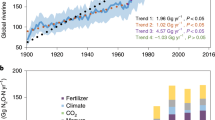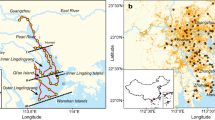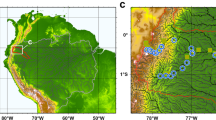Abstract
Nitrous oxide is a potent greenhouse gas, and it destroys stratospheric ozone1. Seventeen per cent of agricultural nitrous oxide emissions come from the production of nitrous oxide in streams, rivers and estuaries2, in turn a result of inorganic nitrogen input through leaching, runoff and sewage. The Intergovernmental Panel on Climate Change and global nitrous oxide budgets assume that riverine nitrous oxide emissions increase linearly with dissolved inorganic nitrogen loads, but data are sparse and conflicting2,3. Here we report measurements over two years of nitrous oxide emissions in the Grand River, Canada, a seventh-order temperate river that is affected by agricultural runoff and outflow from a waste-water treatment plant. Emissions were disproportionately high in urban areas and during nocturnal summer periods. Moreover, annual emission estimates that are based on dissolved inorganic nitrogen loads overestimated the measured emissions in a wet year and underestimated them in a dry year. We found no correlations of nitrous oxide emissions with nitrate or dissolved inorganic nitrogen, but detected negative correlations with dissolved oxygen, suggesting that nitrate concentrations did not limit emissions. We conclude that future increases in nitrate export to rivers will not necessarily lead to higher nitrous oxide emissions, but more widespread hypoxia most likely will.
This is a preview of subscription content, access via your institution
Access options
Subscribe to this journal
Receive 12 print issues and online access
$259.00 per year
only $21.58 per issue
Buy this article
- Purchase on Springer Link
- Instant access to full article PDF
Prices may be subject to local taxes which are calculated during checkout


Similar content being viewed by others
References
Ravishankara, A. R., Daniel, J. S. & Portmann, R. W. Nitrous oxide (N2O): The dominant ozone-depleting substance emitted in the 21st Century. Science 326, 123–125 (2009).
Syakila, A. & Kroeze, C. The global nitrous oxide budget revisited. Greenhouse Gas Meas. Manage. 1, 17–26 (2011).
Nevison, C. Review of the IPCC methodology for estimating nitrous oxide emissions associated with agricultural leaching and runoff. Chemosphere 2, 493–500 (2000).
IPCC Climate Change 2007: The Physical Science Basis. (Cambridge Univ. Press, 2007).
Clough, T. J., Buckthought, L. E., Kelliher, F. M. & Sherlock, R. R. Diurnal fluctuations of dissolved nitrous oxide (N2O) concentrations and estimates of N2O emissions from a spring-fed river: implications for IPCC methodology. Glob. Change Biol. 13, 1016–1027 (2007).
AquaResources, Inc. Integrated Watershed Report: Grand River Watershed. http://www.sourcewater.ca/swp_watersheds_grand/Grand_2009WaterBudget_final.pdf (2009).
Cook, S. Water quality in the Grand River: A summary of current conditions (2000–2004) and long-term trends. http://www.grandriver.ca/water/2006_waterquality_1.pdf (2006).
Environment Canada. Grand River near Doon: 2006 daily discharge. http://www.wsc.ec.gc.ca/applications/H2O/report-eng.cfm?yearb=&yeare=&station=02GA048&report=daily&data=flow&year=2006 (2010).
McElroy, M. B. et al. Production and release of N2O from the Potomac Estuary. Limnol. Oceanogr. 23, 1168–1182 (1978).
Beaulieu, J. J., Shuster, W. D. & Rebholz, J. A. Nitrous oxide emissions from a large, impounded river: The Ohio River. Environ. Sci. Technol. 44, 7527–7533 (2010).
Rosamond, M. S., Thuss, S. J., Schiff, S. L. & Elgood, R. J. Coupled cycles of dissolved oxygen and nitrous oxide in rivers along a trophic gradient in southern Ontario, Canada. J. Environ. Qual. 40, 256–270 (2011).
O’Connor, D. J. & Dobbins, W. E. Mechanism of reaeration in natural streams. ASCE Trans. 2934, 641–684 (1958).
Harrison, J. A., Matson, P. A. & Fendorf, S. E. Effects of a diel oxygen cycle on nitrogen transformations and greenhouse gas emissions in a eutrophied subtropical stream. Aquat. Sci. 67, 308–315 (2005).
Clough, T. J., Bertram, J. E., Sherlock, R. R., Leonard, R. L. & Nowicki, B. L. Comparison of measured and EF5-r-derived N2O fluxes from a spring-fed river. Glob. Change Biol. 12, 477–488 (2006).
Ensign, S. H. & Doyle, M. W. Nutrient spiralling in streams and river networks. J. Geophys. Res. 111, G04009 (2006).
Reay, D. S. et al. Indirect nitrous oxide emissions: Revised emission factors. Environ. Sci. 2, 153–158 (2005).
Codispoti, L. Interesting times for marine N2O. Science 327, 1339–1340 (2010).
Seitzinger, S. P. et al. Global patterns of dissolved inorganic and particulate nitrogen inputs to coastal systems: Recent conditions and future projections. Estuaries 25, 640–655 (2002).
Seitzinger, S. P., Harrison, J. A., Dumont, E., Beuson, A. H. W. & Bouwman, A. F. Sources and delivery of carbon, nitrogen, and phosphorus to the coastal zone: An overview of Global Nutrient Export from Watersheds (NEWS) models and their applications. Glob. Biogeochem. Cycles 19, GB4S01–GB4S11 (2005).
Dodds, W. K., Jones, J. R. & Welch, E. B. Suggested classification of stream trophic state: Distributions of temperate stream types by chlorophyll, total nitrogen, and phosphorus. Water Res. 32, 1455–1462 (1998).
American Public Health Association Standard Methods for the Examination of Water and Wastewater (APHA, 1995).
Venkiteswaran, J. J., Wassenaar, L. A. & Schiff, S. L. Dynamics of dissolved oxygen isotopic ratios: A transient model to quantify primary production, community respiration, and air-water exchange in aquatic ecosystems. Oecologia 153, 385–398 (2007).
Wassenaar, L. I., Venkiteswaran, J. J., Schiff, S. L. & Koehler, G. Aquatic community metabolism response to municipal effluent inputs in rivers quantified using diel d18O values of dissolved oxygen. Can. J. Fish. Aquat. Sci. 67, 1232–1246 (2010).
Crusius, J. & Wanninkhof, R. Gas transfer velocities measured at low wind speed over a lake. Limnol. Oceanogr. 48, 1010–1017 (2003).
Weiss, R. F. The solubility of nitrogen, oxygen and argon in water and seawater. Deep-Sea Res. 17, 721–735 (1970).
Anderson, M. Assessment of Future Water Quality Conditions in the Grand and Speed Rivers. http://www.grandriver.ca/waterplan/TechBrief_AssimilativeCapacity_2012.pdf (2012).
Seglenieks, F. University of Waterloo Weather Station Archives. http://weather.uwaterloo.ca/data.html (2011).
Acknowledgements
We thank R. Elgood and the students and technicians of the Environmental Geochemistry Laboratory at the University of Waterloo for field and laboratory assistance. M. Anderson and D. Boyd of the Grand River Conservation Authority provided site access and river surface area and flow data. We thank J. Venkiteswaran for calculating the error on gas exchange values, performing statistical tests and manuscript editing. Figure creation was greatly aided by P. Aukes. Financial support was provided by the Natural Science and Engineering Research Council (NSERC) of Canada and BIOCAP. Student scholarships were provided by Environment Canada’s Science Horizons Program, NSERC, Ontario Graduate Scholarships and the University of Waterloo.
Author information
Authors and Affiliations
Contributions
S.L.S., M.S.R. and S.J.T. designed the sampling protocol. M.S.R. and S.J.T. collected and analysed water samples and analysed data. M.S.R. and S.L.S. wrote the paper.
Corresponding author
Ethics declarations
Competing interests
The authors declare no competing financial interests.
Supplementary information
Supplementary Information
Supplementary Information (PDF 3079 kb)
Rights and permissions
About this article
Cite this article
Rosamond, M., Thuss, S. & Schiff, S. Dependence of riverine nitrous oxide emissions on dissolved oxygen levels. Nature Geosci 5, 715–718 (2012). https://doi.org/10.1038/ngeo1556
Received:
Accepted:
Published:
Issue Date:
DOI: https://doi.org/10.1038/ngeo1556
This article is cited by
-
Temperature outweighs light and flow as the predominant driver of dissolved oxygen in US rivers
Nature Water (2023)
-
River ecosystem metabolism and carbon biogeochemistry in a changing world
Nature (2023)
-
Andean headwater and piedmont streams are hot spots of carbon dioxide and methane emissions in the Amazon basin
Communications Earth & Environment (2023)
-
Temperature and carbon availability interact to enhance nitrous oxide production via denitrification in alluvial plain river sediments
Biogeochemistry (2023)
-
Greenhouse gas dynamics in an urbanized river system: influence of water quality and land use
Environmental Science and Pollution Research (2022)



